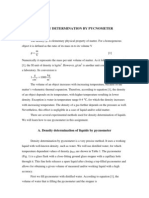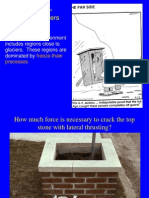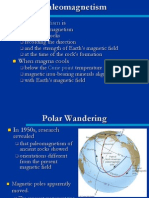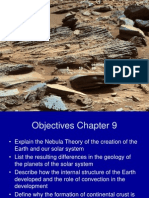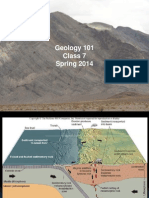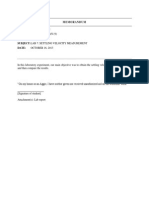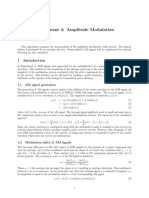PETE 311 Lab 1 Memo
Uploaded by
Tyler MroskoPETE 311 Lab 1 Memo
Uploaded by
Tyler MroskoMEMORANDUM
TO: AHMED ASSEM
FROM: DEVON HILLMAN
PETE 311 503
SUBJECT: LAB NO 1: CORE DIMENSIONS, LIQUD DENSITY, AND ACID TEST
DATE: AUGUST 28, 2013
In this laboratory experiment, our main objective was to learn how to use basic tools like a caliper,
density meter, and a pycnometer.
On my honor as an Aggie, I have neither given nor received unauthorized aid on this academic work.
[Signature of student]
Attachment(s): Lab report
Title: Lab 1: Core Dimensions, Liquid Density, and Acid Test
Discussion and Results
For the first part of this experiment, the length and diameter of three different core samples was measured
using a dial caliper. The dial caliper used in this lab provided a direct reading in inches. Table 1, below,
shows the diameter and length measurements for the three different core samples.
Table 1 Diameter and length of the core samples.
Core Sample Diameter Average Diameter Length Average Length
1
.986
.987
.751
.752 .985 .753
.989 .751
2
.983
.985
1.503
1.507 .987 1.513
.985 1.504
3
1.464
1.464
5.982
5.983 1.464 5.982
1.464 5.984
In the next part of the experiment, the density of water was measured using a density meter and a 50mL
pycnometer. A density meter measures the density of a liquid by pumping a small amount of liquid into
the measuring chamber. In order to get a proper reading, the measuring cell had to be completely clean
before pumping water into it. The other way the density of water was measured was by using a
pycnometer. A pycnometer is a small glass bottle with a glass stopper. In order to find the density of the
liquid inside the pycnometer, you first measure the mass of the empty pycnometer and then you measure
the mass of the pycnometer when it is filled with water. The water density of the water in the pycnometer
can then be determined by using Eq. 1. The results for the water density measurements are shown below
in Table 2.
. (1)
=
-
= .984g/mL
Table 2 Density measurements.
Density Meter Measurement Pycnometer Measurement
.998 g/cm
3
.984 g/mL
The third part of this experiment included testing how three different types of rocks reacted to
hydrochloric acid. When the hydrochloric acid was added to the first rock, bubbles started to fizz
immediately. This led to the assumption that that particular type of rock contained carbonate. When the
hydrochloric acid was added to the second rock, bubbles were barely visible but they were still there.
This led to the assumption that carbonate is present but not overpowering. When the hydrochloric acid
was added to the third rock no bubbles or any type of reaction was visible. This led to the assumption
that this rock type contained little or no amounts of carbonate. Due to how each type of rock reacted to
the hydrochloric acid, it can be concluded that the first rock was limestone, the second rock was dolomite,
and the third rock was sandstone.
Conclusion
In summary, this lab taught some necessary basic measuring skills that petroleum engineers use on a
regular basis. This experiment taught me how to properly read a dial caliper and how to use a density
meter and a pycnometer. I also learned how different types of rock samples react to hydrochloric acid.
You might also like
- Reservoir Fluid Properties: Soran University Faculty of Engineering Petroleum Engineering Department 2 StageNo ratings yetReservoir Fluid Properties: Soran University Faculty of Engineering Petroleum Engineering Department 2 Stage9 pages
- Lab Report 1: Core Dimensions, Liquid Density, and Acid TestNo ratings yetLab Report 1: Core Dimensions, Liquid Density, and Acid Test2 pages
- Reservoir Fluid Properties: Soran University Faculty of Engineering Petroleum Engineering Department 2 StageNo ratings yetReservoir Fluid Properties: Soran University Faculty of Engineering Petroleum Engineering Department 2 Stage9 pages
- Petroleum Properties LAB: Soran University Faculty of Engineering Department of Petroleum EngineeringNo ratings yetPetroleum Properties LAB: Soran University Faculty of Engineering Department of Petroleum Engineering8 pages
- Experiment No. 1 Density of Liquid FormatNo ratings yetExperiment No. 1 Density of Liquid Format6 pages
- Expt 05_DETERMINATION OF DENSITY OF LIQUIDS AND GRANULAR SOLIDSNo ratings yetExpt 05_DETERMINATION OF DENSITY OF LIQUIDS AND GRANULAR SOLIDS4 pages
- Soran University Faculty of Engineering Department of Chemical EngineeringNo ratings yetSoran University Faculty of Engineering Department of Chemical Engineering8 pages
- Experiment No. 1 Density of Unknown Liquid: I. ObjectiveNo ratings yetExperiment No. 1 Density of Unknown Liquid: I. Objective6 pages
- Soran University Faculty of Engineering Department of Petroleum EngineeringNo ratings yetSoran University Faculty of Engineering Department of Petroleum Engineering8 pages
- Density Determination by Pycnometer Method Lab Report (Bacsarpa, XJ)100% (1)Density Determination by Pycnometer Method Lab Report (Bacsarpa, XJ)6 pages
- Density and Relative Density: Experiment NO.1No ratings yetDensity and Relative Density: Experiment NO.113 pages
- Measurement of Densities and Specific Gravities: Mapúa UniversityNo ratings yetMeasurement of Densities and Specific Gravities: Mapúa University7 pages
- Petroleum Report Experiment Lab OutlinesNo ratings yetPetroleum Report Experiment Lab Outlines5 pages
- Experiment No 8 - Density of Given Sample of WaterNo ratings yetExperiment No 8 - Density of Given Sample of Water2 pages
- Experiment 1 - Fluid Properties AppratusNo ratings yetExperiment 1 - Fluid Properties Appratus13 pages
- Drilling Experiment Find Density OutlinesNo ratings yetDrilling Experiment Find Density Outlines5 pages
- Chemistry 1A Experiment 1: Density CSUS Department of ChemistryNo ratings yetChemistry 1A Experiment 1: Density CSUS Department of Chemistry10 pages
- There Are Two Ways To Measure The Density 1. Hydrometers 2. Baknometers A Stopper Capillary: A Hydrometer Is AnNo ratings yetThere Are Two Ways To Measure The Density 1. Hydrometers 2. Baknometers A Stopper Capillary: A Hydrometer Is An21 pages
- Experiment 1: Density Determinations and Various Methods To Measure VolumeNo ratings yetExperiment 1: Density Determinations and Various Methods To Measure Volume7 pages
- Determination: Density, Specific Gravity and Viscosity of Liquid FuelsNo ratings yetDetermination: Density, Specific Gravity and Viscosity of Liquid Fuels10 pages
- Measurements of Densities and Specific Gravity: CE121L - A06No ratings yetMeasurements of Densities and Specific Gravity: CE121L - A067 pages
- Laboratory Techniques Lab Report: Option One: Density Measurements Virtual LabNo ratings yetLaboratory Techniques Lab Report: Option One: Density Measurements Virtual Lab4 pages
- Muaz Malik - Measurement and Uncertainty Density LabNo ratings yetMuaz Malik - Measurement and Uncertainty Density Lab4 pages
- Junk Drawer Chemistry: 50 Awesome Experiments That Don't Cost a ThingFrom EverandJunk Drawer Chemistry: 50 Awesome Experiments That Don't Cost a Thing4/5 (4)
- Glacial Geomorphology: - Ice Has Advanced and Retreated Across Continental Land Many Times Throughout Geologic HistoryNo ratings yetGlacial Geomorphology: - Ice Has Advanced and Retreated Across Continental Land Many Times Throughout Geologic History66 pages
- Life On Earth Is A Constant Battle Between The Tectonic Forces That Want To Make The Earth LUMPY and The Geomorphic Agents That Want To Make The Earth SMOOTHNo ratings yetLife On Earth Is A Constant Battle Between The Tectonic Forces That Want To Make The Earth LUMPY and The Geomorphic Agents That Want To Make The Earth SMOOTH37 pages
- Physiology of Solid' Earth - Driving Mechanism For Plate TectonicsNo ratings yetPhysiology of Solid' Earth - Driving Mechanism For Plate Tectonics8 pages
- Groundwater Important Because It Is Where The Accessible Fresh Water Is !!!No ratings yetGroundwater Important Because It Is Where The Accessible Fresh Water Is !!!24 pages
- Geology 101 Class 11 SPRING 2014: Question of The Day - Do Otters Contribute To Sedimentary Rock Formation?No ratings yetGeology 101 Class 11 SPRING 2014: Question of The Day - Do Otters Contribute To Sedimentary Rock Formation?80 pages
- GEOLOGY 101 Sections 519-527 Spring 2014 Class 3No ratings yetGEOLOGY 101 Sections 519-527 Spring 2014 Class 344 pages
- Experiment 4: Amplitude Modulation: 1.1 AM Signal GenerationNo ratings yetExperiment 4: Amplitude Modulation: 1.1 AM Signal Generation6 pages
- Analytical Calculation Methods of Riverbank Filtration0% (1)Analytical Calculation Methods of Riverbank Filtration6 pages
- A Practical Guide On How To Stop People-Pleasing and Start Being Yourself100% (2)A Practical Guide On How To Stop People-Pleasing and Start Being Yourself54 pages
- Bitcoinheist: Topological Data Analysis For Ransomware Prediction On The Bitcoin BlockchainNo ratings yetBitcoinheist: Topological Data Analysis For Ransomware Prediction On The Bitcoin Blockchain7 pages
- Visualizing Human Biology VISUALIZING SERIES Kathleen A. Ireland - Download the entire ebook instantly and explore every detail100% (1)Visualizing Human Biology VISUALIZING SERIES Kathleen A. Ireland - Download the entire ebook instantly and explore every detail51 pages
- Hacking, Ian - Strange Expectations (1980)No ratings yetHacking, Ian - Strange Expectations (1980)6 pages
- DOL Starter of 3-Phase Induction Motor-PRAC1No ratings yetDOL Starter of 3-Phase Induction Motor-PRAC11 page
- Iv - Procedures: Republic of The Philippines Department of EducationNo ratings yetIv - Procedures: Republic of The Philippines Department of Education3 pages
- 1086 Impurities in Drug Substances and Drug: ProductsNo ratings yet1086 Impurities in Drug Substances and Drug: Products7 pages
- FMDS07111G- AMMONIA AND AMMONIA DERIVATIVES100% (1)FMDS07111G- AMMONIA AND AMMONIA DERIVATIVES9 pages
- Understandinf The Self - GED110 FA6 - Gender and The SexNo ratings yetUnderstandinf The Self - GED110 FA6 - Gender and The Sex3 pages
- Vdoc - Pub Handbook of Communications DisordersNo ratings yetVdoc - Pub Handbook of Communications Disorders971 pages
- 2 VDPA:Wirespeed Virtual Networking——张雅兰No ratings yet2 VDPA:Wirespeed Virtual Networking——张雅兰28 pages
- For Intervention Detailed Lesson Plan in English Grade 9No ratings yetFor Intervention Detailed Lesson Plan in English Grade 922 pages
- SSR of Dr. MGR Fisheries College and Research Institute, ThalainayeruNo ratings yetSSR of Dr. MGR Fisheries College and Research Institute, Thalainayeru90 pages

































